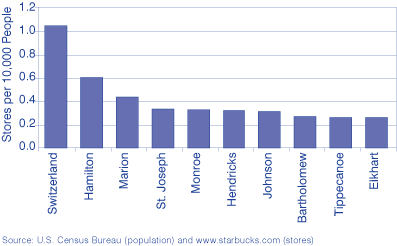Starbucks Follows the Wealthy and the College Kids
A recent weblog article by a security analyst/portfolio manager described how he uses Starbucks’ same-store sales as an informal economic indicator. He explains that “quarterly comparable store sales for Starbucks is an indicator of consumer sentiment” and that “for most consumers, nothing Starbucks sells in its stores is essential. If their customers are more budget-conscious this year than they were last year, latte purchases will suffer. If customers feel better about their near-term financial picture, an extra one now and then doesn’t seem so frivolous.”
Another website, ePodunk (www.epodunk.com), which provides data on communities around the country and creates various lists and rankings, published an article on coffee quotients, a measure of the number of Starbucks stores per 10,000 people in cities across the nation. The article begins by stating that “there are those who believe that a town without Starbucks is just a small step above barbarism. Others, with some justification, view the spread of the Seattle-based company as the caffeine equivalent of Disneyfication.”
So where are the Starbucks stores in Indiana? By using Starbucks’ current location list on its website, we can learn how many there are and where they are located. Concentration ratios can be calculated using Census Bureau 2004 population estimates and median household income and age data, available from the 2000 Census for Indiana counties.
Two general trends become clear about Indiana’s “Starbucks Counties.” The wealthier counties and those with large concentrations of college students tend to have more Starbucks stores (see Figure 1).
Figure 1: Top Ten Counties by Starbucks Concentration, 2004

There are two anomalies, which can be easily explained. First, the county with the highest concentration of Starbucks is Switzerland County, which has an estimated population of 9,508 and one Starbucks (located in the Belterra Casino Resort and Spa). Second, Marion County has the third highest concentration of Starbucks stores, with an estimated population of 863,596 and a total of 38 stores. Considering nearly 15 percent of all Hoosiers live in Marion County, home to Indianapolis, it is not surprising to find such a high concentration of Starbucks stores. One might also factor in the urban professionals needing large quantities of caffeine in order to put in their 10- to 12-hour days.
The wealthier counties are Hamilton, Hendricks, Johnson and Bartholomew, with median household incomes ranging from $44,184 to $71,026 (the state median is $41,567). Rounding out the top ten are St. Joseph, Monroe and Tippecanoe counties, home to Notre Dame, Indiana University and Purdue, where the college-age population (18 to 24) ranges from 11.8 to 27.7 percent of the total population (the state average is 10.1 percent).
U.S. Hispanic Population Exceeds 40 Million
In June, the Census Bureau released its latest national estimates by race, Hispanic origin and age. The data, which reflects estimates as of July 1, 2004, showed that the nation’s Hispanic population reached 41.3 million, an increase of 1.4 million (3.6 percent) over a 12-month period. Hispanics, who may be of any race, accounted for about one-half of the national population growth of 2.9 million (1 percent) between July 1, 2003, and July 1, 2004. The data also shows that the growth rate of Hispanics was more than three times that of the total population.
The Census Bureau also estimates that there were about 14 million Asians (up 3.4 percent), 977,000 Hawaiians and Pacific Islanders (up 1.7 percent), 39.2 million African Americans (up 1.3 percent), 4.4 million American Indians and Alaska natives (up 1 percent), and 239.9 million whites (up 0.8 percent).
By Frank Wilmot, State Data Center Coordinator
Indiana State Library
